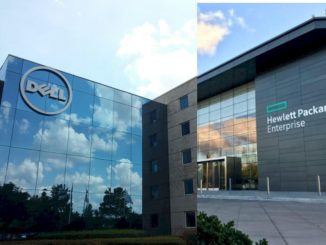
Over the past several years, the server market has been roiled by the rise of cloud computing that run the applications created by companies and by services offered by hyperscalers that augment or replace such applications. This is a tougher and lumpier market, to be sure.
The top tier cloud providers like Amazon, Microsoft, and Google not only have become key drivers in server sales but also have turned to original design manufacturers (ODMs) from Taiwan and China for lower cost systems to help populate their massive datacenters. Overall, global server shipments have slowed, and top-tier OEMs are working to adjust to the new market environment. According to Gartner’s numbers, in the first quarter, only Dell EMC and Huawei saw shipments and revenue grow. Hewlett Packard Enterprise, IBM, and Lenovo all experienced declines in their numbers.
The challenges were highlighted recently when HPE announced its latest financial numbers. Revenue for the company’s servers dropped 14 percent, and revenue for its larger Enterprise Group – which includes servers and storage – fell 13 percent. According to company officials, HPE also was dogged by high commodity prices and challenging competition on prices for systems. That said, HPE is continuing the restructuring that started two years ago when Hewlett-Packard broke in two to create HPE and HP Inc, and more recently has included spinning out its services and software units in hopes of creating a smaller, more nimble and more cost-effective company.
HPE isn’t the only server OEM trying to navigate its way through the myriad challenges presented by the rapidly changing dynamics in datacenters and emerging workloads like cloud computing, software-defined infrastructure, artificial intelligence and machine learning, and data analytics. IBM, Lenovo, and Cisco Systems are among the others that had soft quarterly infrastructure numbers. Over the past several years, HPE has broadened its server portfolio beyond its mainstream, workhorse X86-based ProLiant systems. That has included its Apollo systems for highly dense, hyperscale environments, Synergy composable infrastructure offerings, and Edgeline systems developed with ODM Foxconn for the internet of things (IoT) and network edge computing. In addition, HPE bought supercomputer maker SGI for high-performance computing and SimpliVity to bolster its hyperconverged credentials. In May, HPE announced a partnership with Nvidia to develop GPU-powered Apollo systems based on the SGI ICE architecture and aimed at AI and deep learning workloads.
Also last month, HPE unveiled a prototype of The Machine, a massive single-memory system designed for the big data era that will use such new technologies as memristors and silicon photonics to process huge amounts of data. The prototype features 1,280 Cavium ARM-based CPU cores housed in four Apollo 6000 enclosures that are linked via a high-speed fabric mesh, and 160TB of memory capacity.
The company also is making other acquisitions to build out its infrastructure capabilities, including spending $1.2 billion to buy flash storage provider Nimble to help boost its struggling storage business.
Despite all this, HPE over the past few months has shown how vulnerable it is to the new infrastructure reality. In a conference call to discuss the latest quarterly numbers, president and CEO Meg Whitman noted that the company’s server business was hurt by the continued decline in orders from a “tier-one” customer. (Whitman declined to name the vendor, though the belief is that it’s Microsoft.) She expects that orders from the customer will continue to slow and will continue to hit the company’s bottom line for the next few quarters. She also said HPE is reconsidering whether continuing to pursue such business makes sense.
“We’re really thinking hard about what the future strategy is for tier one,” Whitman said. “We continue to get new tier-one customers, but this is low calorie business actually, and so we need to think it through. Does it make sense to continue that business on a go-forward basis or are we better off actually putting our selling resources and our R&D resources against more margin-rich sustainable profitability?”
Among all these challenges, HPE officials at its Discover show this week are putting the focus on its upcoming next-generation ProLiant servers, which comes two weeks after the company unveiled a range of new storage products. The systems will be powered by Intel’s upcoming “Skylake” Xeon server chips, but HPE officials said little about those processors, adding that more information will come when Intel releases the chips later this summer. Last month, Dell EMC officials announced their upcoming 14G PowerEdge systems, and similarly could say little about many aspects of the systems because of non-disclosure agreements with Intel.
With that in mind, HPE officials at the show are focusing on innovations around security and software-defined capabilities of the new systems, particularly in the area of composable infrastructure, where compute and storage is viewed as a fluid pool of resources that can be quickly deployed for greater flexibility and agility. Central to this effort is OneView 3.1, which HPE is using to take storage components and put them into resource pools. In partnership with Intel and its Skylake Xeon technologies, OpenView 3.1 also is delivering intelligent system tuning to enable the Gen 10 ProLiants to boost their performance based on workload demands and to modulate frequency. There also are a range of preset workload settings – such as low latency and power efficiency – which officials said will make it easier to optimize the systems for particular applications. OneView 3.1 will be run across HPE’s various server lines, from ProLiants to Apollo, Superdome and Synergy.
HPE is also extending support for containers, with Docker being bundled with Synergy an HPE Pointnext technologies, enabling them to run Docker Enterprise Edition. In addition, Synergy also will come with Mesosphere integration for automated Mesosphere Enterprise DC/OS deployments across HPE systems, and the vendor is entering a strategic alliance with Mesosphere to develop ways to make it easier for customers to use containers and work in cloud environments. In addition, HPE’s Project New Stack will enable organizations to allocate composable resources not only on-premises but also in the public cloud and allow them to analyze data and find underused resources.
The ProLiants also will have what officials call Scalable Persistent Memory, which use DRAM with flash in a non-volatile DIMM module. NVDIMM enables applications to run more quickly than in traditional storage systems because the data doesn’t need to move between the hard drive and chip. In addition, if the server crashes, the data isn’t lost. HPE officials said the capacity of the NVDIMM modules will jump from 8 GB to 16 GB, and that they bring 27 times faster application checkpoint operation sand 20 times faster database restores than competing models. The company also is demonstrating terabyte-level persistent memory at the show.
To better combat firmware attacks, HPE is adding silicon-level security that officials call a silicon root of trust. It’s a link between the company’s Integrated Lights Out (iLO) firmware and custom HPE iLO silicon that is designed to prevent compromised code from running on the system by creating a “fingerprint” for ProLiant servers. The systems will not boot unless the firmware matches the fingerprint.
The ProLiant announces complement the storage news announced in May, which included a broadening of flash offerings, such as a new 3PAR StoreServ 9450 all-flash array and arrays featuring Nimble technology.





Be the first to comment